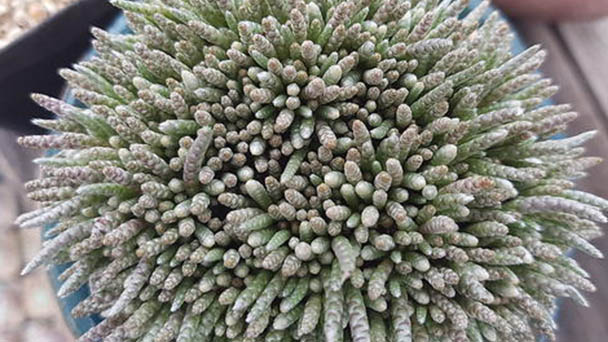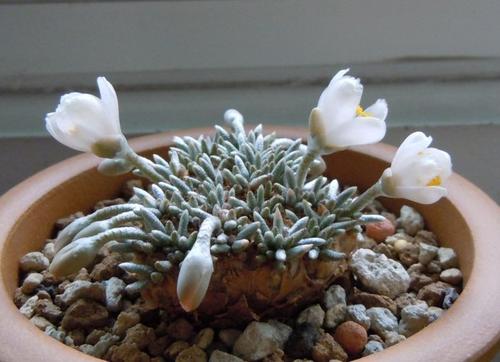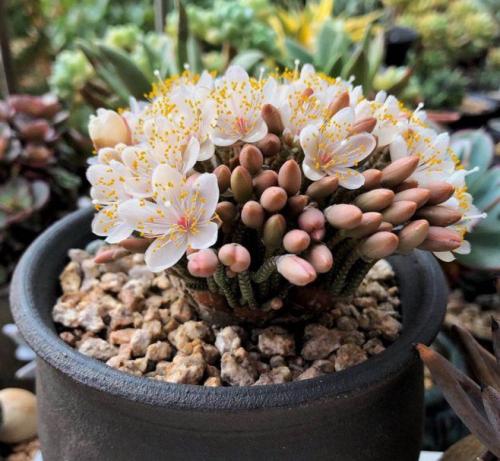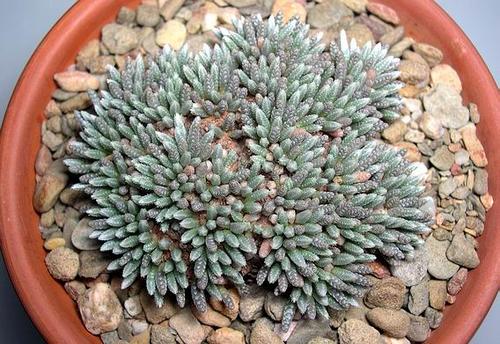Avonia quinaria profile
Written by Maggie
Mar 30 2021

Avonia quinaria is a succulent perennial herb with tuber roots and white and red flowers.
Avonia quinaria picture

Morphological characteristics of Avonia quinaria
The Avonia quinaria plant has an irregular rhizome (commonly known as a root tuber) with a cluster of fine branches at the top. The branches are covered with pale, greenish scaly leaflets. The leaves are small and papery, with stipules surrounding the tiny leaves. Flowers are 5 base, very short flowering period, some species bloom only an hour. Tenacity is self-pollinated and matures for about three weeks. avonia quinaria flowers are in the shape of plum flowers, on the tip of the twigs, about 2 cm in diameter, long stamens, often exceeding the petals, golden anthers on the tip, the petals are silky and white. Flowers in the form of plum flowers, on the tip of twigs, silky white or red petals, usually open in the evening after full sunshine, closed at night, difficult to bloom in rainy weather or in the cultivation of insufficient light, the life of each flower is only 1 to 2 hours, blooming in summer. Each Avonia quinaria blooms for 7 to 10 days.
People "a flash in the pan" is commonly used to describe Avonia quinaria flower of life is short, many of the life of the plant flowers, smaller than the epiphyllum Avonia quinaria is one of them, from bloom to close less than 2 hours, because of the short flowering, plus the plant the introduction of our time is not long, culture is not too common, few people have seen the flowers.It usually blooms in the sunny afternoon and closes at night. The life of each flower is only 4 ~ 5 hours. If it is overcast and rainy or the cultivation environment is not adequately illuminated, it is difficult to open.
Ecological habits of Avonia quinaria
Avonia Quinaria is native to the desert areas of South Africa and Namibia. It likes cool, dry and sunny environments. Avonia quinaria is resistant to drought, and is afraid of water, heat and humidity.
The distribution of Avonia quinaria
Avonia quinaria is native to the deserts of South Africa and Namibia.
The use of Avonia Quinaria for gardens
Avonia quinaria of strange shape, tiny branches and the rhizomes of primitive simplicity set each other off becomes an interest, like a pick on the rock stone sea anemones, and like a dancing measure, and the small plant type, slow growth, like living arts and crafts. Avonia quinaria is suitable for small basin planting, put in the place such as sunlight, windowsill, watch carefully, in your spare time to appreciate its magic charm.

Varieties of Avonia quinaria
The Avonia quinaria is divided into white and red Avonia quinaria.
White Avonia quinaria
The scientific name of the white flower Avonia quinaria is: Avonia quinaria subsp. alstoni
Safflower Avonia quinaria(A. halstonii), with dark pink flowers, is similar in other features. A similar species in the same genus is the silver silkworm (A.albissima), also known as the dance of the goblins, which has a large fleshy short stem, a cluster of fine circular branches, and a surface densely covered with scale-like spiral-shaped leaflets. A. Papyracea, also known as White Snake Dian, has short fleshy stem, fat and branched at most, which is inclined or curved and extends to the ground. The stem surface is covered with white paper leaflets like scales, and the top of the stem is covered with small white and green flowers.
Safflower Avonia quinaria (A.alstonii) with dark pink flowers,
Safflower Avonia quinaria
The scientific name of the red flower Avonia quinaria is: Avonia quinaria subsp. quinaria
Other name: anacampseros Quinaria
Other characteristics are basically the same as those of Avonia Quinaria.A similar species in the same genus is the silver silkworm (A.albissima), also known as the dance of the goblins, which has a large fleshy short stem, a cluster of fine circular branches, and a surface densely covered with scale-like spiral-shaped leaflets. A. Papyracea, also known as White Snake Dian, has short fleshy stem, fat and branched at most, which is inclined or curved and extends to the ground. The stem surface is covered with white paper leaflets like scales, and the top of the stem is covered with small white and green flowers.
The Avonia Quinaria method of propagation
Avonia quinaria can be used for propagation by seeding.
How to grow and care for Avonia quinaria
Avonia quinaria has a strong habit and is easy to maintain. It grows very slowly and needs patience to cultivate. In summer, it can be shaded properly or even exposed to dew. Avonia quinaria is not cold tolerant. If the temperature is below 10℃ in winter, water should be properly controlled or cut off. The basin soil should be kept dry and can tolerate the low temperature of -5℃ in winter, and light should be given as much as possible in winter. For Avonia Quinaria, loose and breathable media, such as peat/coconut bran, and granular soil should be selected. The size of granular soil is recommended to be 1-3mm, and the proportion of granular soil should be relatively high.

Latest Updated
- Benefits of Bugleweed - 7 Science-backed Health Benefits
- Bugleweed Dangers & Side Effects - Is It Poisonous?
- How to Plant Evergreen Trees - What You Should Know
- When to Plant Evergreens - Grow Guide for Evergreen Trees
- 12 Wonderful Evergreen Shrubs for Your Garden
- 12 Popular Evergreen Plants with Pictures for Beginners
- When And How To Prune A Lilac Bush Like a Pro
- How to Grow & Care for Lilac Vine (Hardenbergia Violacea)
- Japanese Lilac Tree (Syringa Reticulata) Care & Propagation Guide
- Shumard Oak Pros and Cons - What to Know
Popular Articles
- Winter maintenance of Antirrhinum Majus
- How to Grow Terminalia Mantaly Tree
- How to Grow and Care for Crossostephium Chinense
- How to grow Antirrhinum Majus in spring
- Peristeria Elata (Dove Orchid) Profile: Info & Care Guide
- Underwatered Snake Plant (Sansevieria Trifasciata) - Signs And How To Fix
- How to Care for Brazilian Jasmine Plant (Mandevilla Sanderi)
- How to Grow & Care for Graptopetalum Purple Delight in Summer
- Rosa Chinensis (China Rose): Plant Growing & Care Tips
- How to Care for Baby Sun Rose (Aptenia Cordifolia)